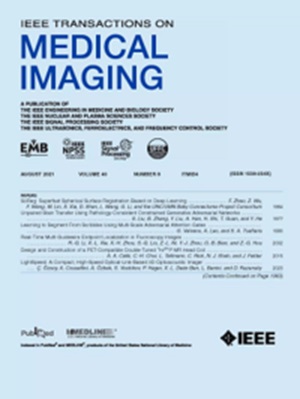One-Shot Generative Adversarial Learning for MRI Segmentation of Craniomaxillofacial Bony Structures
IF 8.9
1区 医学
Q1 COMPUTER SCIENCE, INTERDISCIPLINARY APPLICATIONS
引用次数: 26
Abstract
Compared to computed tomography (CT), magnetic resonance imaging (MRI) delineation of craniomaxillofacial (CMF) bony structures can avoid harmful radiation exposure. However, bony boundaries are blurry in MRI, and structural information needs to be borrowed from CT during the training. This is challenging since paired MRI-CT data are typically scarce. In this paper, we propose to make full use of unpaired data, which are typically abundant, along with a single paired MRI-CT data to construct a one-shot generative adversarial model for automated MRI segmentation of CMF bony structures. Our model consists of a cross-modality image synthesis sub-network, which learns the mapping between CT and MRI, and an MRI segmentation sub-network. These two sub-networks are trained jointly in an end-to-end manner. Moreover, in the training phase, a neighbor-based anchoring method is proposed to reduce the ambiguity problem inherent in cross-modality synthesis, and a feature-matching-based semantic consistency constraint is proposed to encourage segmentation-oriented MRI synthesis. Experimental results demonstrate the superiority of our method both qualitatively and quantitatively in comparison with the state-of-the-art MRI segmentation methods.一次生成对抗学习在颅颌面骨结构MRI分割中的应用
与计算机断层扫描(CT)相比,磁共振成像(MRI)描绘颅颌面(CMF)骨骼结构可以避免有害的辐射暴露。但MRI显示骨边界模糊,训练时需要借鉴CT的结构信息。这是具有挑战性的,因为配对的MRI-CT数据通常很少。在本文中,我们建议充分利用通常丰富的未配对数据,以及单个配对的MRI- ct数据,构建一个一次性生成对抗模型,用于CMF骨结构的MRI自动分割。我们的模型包括一个学习CT和MRI之间映射的跨模态图像合成子网络和一个MRI分割子网络。这两个子网以端到端的方式进行联合训练。此外,在训练阶段,提出了基于邻域的锚定方法来减少跨模态合成中固有的歧义问题,并提出了基于特征匹配的语义一致性约束来促进面向分割的MRI合成。实验结果表明,我们的方法在定性和定量上都优于最先进的MRI分割方法。
本文章由计算机程序翻译,如有差异,请以英文原文为准。
求助全文
约1分钟内获得全文
求助全文
来源期刊

IEEE Transactions on Medical Imaging
医学-成像科学与照相技术
CiteScore
21.80
自引率
5.70%
发文量
637
审稿时长
5.6 months
期刊介绍:
The IEEE Transactions on Medical Imaging (T-MI) is a journal that welcomes the submission of manuscripts focusing on various aspects of medical imaging. The journal encourages the exploration of body structure, morphology, and function through different imaging techniques, including ultrasound, X-rays, magnetic resonance, radionuclides, microwaves, and optical methods. It also promotes contributions related to cell and molecular imaging, as well as all forms of microscopy.
T-MI publishes original research papers that cover a wide range of topics, including but not limited to novel acquisition techniques, medical image processing and analysis, visualization and performance, pattern recognition, machine learning, and other related methods. The journal particularly encourages highly technical studies that offer new perspectives. By emphasizing the unification of medicine, biology, and imaging, T-MI seeks to bridge the gap between instrumentation, hardware, software, mathematics, physics, biology, and medicine by introducing new analysis methods.
While the journal welcomes strong application papers that describe novel methods, it directs papers that focus solely on important applications using medically adopted or well-established methods without significant innovation in methodology to other journals. T-MI is indexed in Pubmed® and Medline®, which are products of the United States National Library of Medicine.
 求助内容:
求助内容: 应助结果提醒方式:
应助结果提醒方式:


